Making of Ladies v/s Ricky Bahl
[dropcap]A[/dropcap]n aptly named film, Ladies vs. Ricky Bahl is just that – a story about a con artist specializing in swindling women out of money. As they say, hell hath no fury like a woman scorned. In this case three of his former female victims set out to exact revenge, attempting to ‘con the con’ with the assistance of a very chirpy and convincingly adept sales girl. The film was shot throughout India following Ricky as he unveils numerous disguises and exercises his skills on unsuspecting women.
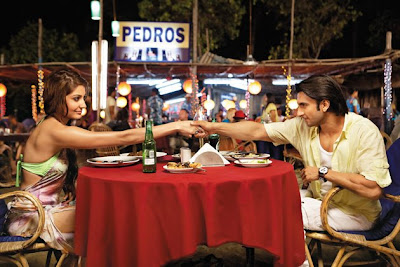
The majority of filming took place at a combination of exterior and practical locations. Aseem describes it as being, “largely outdoors except for a few scenes such as the Chadha’s office. Chadha’s house was at a real location, we located a house that had big wings next to the bed. We looked at it and we laughed and said, ‘this was it’. It was very appropriate.” The various sites for the shoot were as realistic as possible Aseem asserts, “Most of the look that we created is very real. For example, if you see the lane in which the Lucknow part was shot in, it was a real lane with real shops. Even the bus stand was real. I try and shoot between 2.8 and 4 to maintain similar depth of field throughout.”

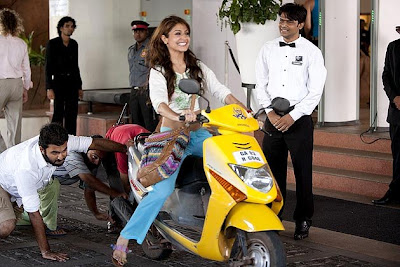
Aseem disclosed that the Director of the film, Maneesh Sharma, had a certain picture in mind, which developed as shooting progressed. He states, “Since I don’t see films much I don’t have direct references but I do experiment and use whatever is available. The look evolved during the shoot during constant conversations with Maneesh.”
Aseem also gives due acknowledgement to Wasiq Khan’s Art Direction praising him for his sincere and skillful work, building many sets from scratch. He says, “It was the first time I worked with him and it was a superb experience. His sense of detail is very high and he comes across as a very good human being. And what matters in the field of art is addressing whom you are deep inside. He has done a fantastic job. Chadha’s office was very creative. It is one of the small sets, which was done brilliantly. There was a lot of detailing. There were so many elements on that table such as the Mandir (temple) with lights. Wasiq continuously brainstormed about what element(s) we could add to enhance the scene further through props and set design. We had similar tastes. He gave a special touch to everything. Lucknow and Goa involved a lot of art direction including a sports shack that was constructed from scratch on a empty beach located in South Goa behind the TAJ (Exotica).”
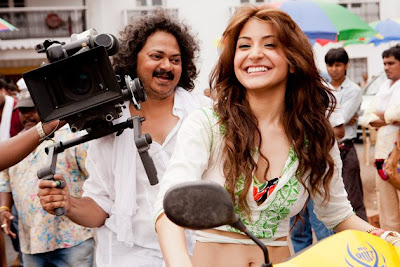
 Wasiq and Aseem both seem to be of the same mind when asked about the most elaborate lighting setup, they referred to the first scene that begins with a dance sequence featuring the song ‘Jigar da Tukda’. Aseem states that, “there were some 8 – 9 moving locations in one night so parallel lighting was happening. For this song, Vaibhavi (choreographer) and I didn’t want to do anything conventional. So we brainstormed a lot and when we arrived at the YRF (Yash Raj Films) studio we decided to put Kino tubes on the catwalk. Wasiq was very excited. We placed lights on the inner portion of the catwalk; the glow wasn’t enough so we placed them outside too. The catwalk was on hydraulics, which gave an interesting feel, somewhat like a spacecraft. The idea just struck us on the spot and we executed it. Wasiq adds, “We had to create a club in that song. So we shot in YRF. The hydraulic catwalk looked very futuristic. We played with a lot of lighting. On the background we made it black and added glitter. In the mall we used 4 Dinos, one 18k, and a few smaller units. The majority of the ambient lighting for the wide shot came from the mall.”
Wasiq and Aseem both seem to be of the same mind when asked about the most elaborate lighting setup, they referred to the first scene that begins with a dance sequence featuring the song ‘Jigar da Tukda’. Aseem states that, “there were some 8 – 9 moving locations in one night so parallel lighting was happening. For this song, Vaibhavi (choreographer) and I didn’t want to do anything conventional. So we brainstormed a lot and when we arrived at the YRF (Yash Raj Films) studio we decided to put Kino tubes on the catwalk. Wasiq was very excited. We placed lights on the inner portion of the catwalk; the glow wasn’t enough so we placed them outside too. The catwalk was on hydraulics, which gave an interesting feel, somewhat like a spacecraft. The idea just struck us on the spot and we executed it. Wasiq adds, “We had to create a club in that song. So we shot in YRF. The hydraulic catwalk looked very futuristic. We played with a lot of lighting. On the background we made it black and added glitter. In the mall we used 4 Dinos, one 18k, and a few smaller units. The majority of the ambient lighting for the wide shot came from the mall.”
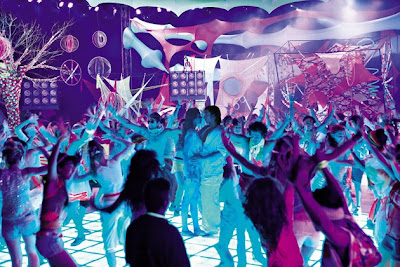 Some other interesting scenes were the ‘After Party sequence’ in which Dinos and UV lights were utilized. They were on dimmers and had “lights around them giving an illusion of the light moving and panning at them. The whole sequence was shot on a Steadicam.”
Some other interesting scenes were the ‘After Party sequence’ in which Dinos and UV lights were utilized. They were on dimmers and had “lights around them giving an illusion of the light moving and panning at them. The whole sequence was shot on a Steadicam.”
On being asked about his favorite scene Aseem says he likes two of them. One shot in “Lucknow where the protagonists have Kulfi and Ricky Bahl (Ranveer Singh) shows Saira Rashid (Aditi Sharma) the zardozi”. The second one is the mid-movie interval shot where Ranveer is revealed as Diego Vaz. The glamour body shot, especially the back shot in which he gets up and stretches his arms came out well in Aseem’s opinion.
From vivacious Delhi, to graceful Lucknow, to zippy Mumbai and finally sensuous Goa, Aseem and his crew were triumphant in setting the exact mood and feel that the script demanded and for that, kudos to them!

Confidence seems to be the mantra for the success of not only Ricky Bahl but also the Cinematographer of the film, Mr. Aseem Mishra. His approach was to alter the look of the movie according to its locations. Aseem revisited his previous work for inspiration. As he puts it, “I just wanted to give each city a different look utilizing elements from my past work. Mumbai would have a ‘New York’ feel, Lucknow would feel like ‘Once upon a time in Mumbai’, Delhi would have some elements from ‘Band Baaja Bharat’ and Goa would be somewhat like ‘Paan Singh Tomar’, which hasn’t released yet.”
The majority of filming took place at a combination of exterior and practical locations. Aseem describes it as being, “largely outdoors except for a few scenes such as the Chadha’s office. Chadha’s house was at a real location, we located a house that had big wings next to the bed. We looked at it and we laughed and said, ‘this was it’. It was very appropriate.” The various sites for the shoot were as realistic as possible Aseem asserts, “Most of the look that we created is very real. For example, if you see the lane in which the Lucknow part was shot in, it was a real lane with real shops. Even the bus stand was real. I try and shoot between 2.8 and 4 to maintain similar depth of field throughout.”

Aseem details some of his setups. “The Goa shots were very harshly lit. It was roughly top lit in most cases. For each city we gave a different tone in a subtle way. Lucknow has a bit of green, Mumbai has blue, and Goa has some warmth. But we never went overboard.” Aseem gives an example of a scene involving natural and artificial light, “When the three girls are spying on Ricky from the shack area watching Ricky in his Goa apartment – We hid a Kino on the ceiling of the tent. The physical distance between the camera and the actors was almost 50 – 80 meters. I shot the whole sequence with an Optimo lens. The main source of light was from the tent. Wasiq Khan (Art Director) had given us space on top of each bed. If I want the skin tone to be slightly warmer I selectively use an 85 filter on tungsten light. I won’t mask everything on the light so it gives me a nice blend of warmth keeping the skin tone intact.”

Following the spirit of the film, Aseem credit his confidence. “I already have a lot of experience with shooting documentaries. I think that experience really helps you and tells you how to quickly react in a natural environment. It is quite instinctive. With good instincts, confidence is important and confidence comes from experience.” When asked to elucidate his craft, he illustrates, “I think if you see the camera movements in Goa, you will notice a lot of swish pans and handheld movements. My feel towards Goa was that it should have a lot of freedom in composition. It shouldn’t be restricted, just like the place – carefree. In Lucknow, there is a lot of elegance so we kept the frames cleanly composed and steady. The place decided the look and feel primarily through color and camera movement. Delhi was real and normal. As I had shot Band Baaja Baarat in Delhi, the hangover was still there. Most of Goa was shot on Steadicam or handheld.”
Aseem disclosed that the Director of the film, Maneesh Sharma, had a certain picture in mind, which developed as shooting progressed. He states, “Since I don’t see films much I don’t have direct references but I do experiment and use whatever is available. The look evolved during the shoot during constant conversations with Maneesh.”
Aseem also gives due acknowledgement to Wasiq Khan’s Art Direction praising him for his sincere and skillful work, building many sets from scratch. He says, “It was the first time I worked with him and it was a superb experience. His sense of detail is very high and he comes across as a very good human being. And what matters in the field of art is addressing whom you are deep inside. He has done a fantastic job. Chadha’s office was very creative. It is one of the small sets, which was done brilliantly. There was a lot of detailing. There were so many elements on that table such as the Mandir (temple) with lights. Wasiq continuously brainstormed about what element(s) we could add to enhance the scene further through props and set design. We had similar tastes. He gave a special touch to everything. Lucknow and Goa involved a lot of art direction including a sports shack that was constructed from scratch on a empty beach located in South Goa behind the TAJ (Exotica).”

Wasiq concurs with Aseem on the sentiment and has a similar admiration for the Cinematographer. He exclaims, “Working with him was a pleasure! We had detailed conversations about how he wanted to go about shooting a scene.” His take on the appearance of the film was along the same lines as Aseem. He said that, “the scenes of Lucknow had to be very real, earthy and static. Whereas Goa had to be more handheld so accordingly I had to be prepared, when it came to drastic camera movements, of what elements will be in frame and what could be added. When the camera is handheld then you as a Art Director need things to place in the foreground or passing props to create depth. A bit of smoke in the shot is a powerful enhancement. Mumbai was supposed to be clean, crisp, and corporate. Delhi was vibrant.”
 Wasiq and Aseem both seem to be of the same mind when asked about the most elaborate lighting setup, they referred to the first scene that begins with a dance sequence featuring the song ‘Jigar da Tukda’. Aseem states that, “there were some 8 – 9 moving locations in one night so parallel lighting was happening. For this song, Vaibhavi (choreographer) and I didn’t want to do anything conventional. So we brainstormed a lot and when we arrived at the YRF (Yash Raj Films) studio we decided to put Kino tubes on the catwalk. Wasiq was very excited. We placed lights on the inner portion of the catwalk; the glow wasn’t enough so we placed them outside too. The catwalk was on hydraulics, which gave an interesting feel, somewhat like a spacecraft. The idea just struck us on the spot and we executed it. Wasiq adds, “We had to create a club in that song. So we shot in YRF. The hydraulic catwalk looked very futuristic. We played with a lot of lighting. On the background we made it black and added glitter. In the mall we used 4 Dinos, one 18k, and a few smaller units. The majority of the ambient lighting for the wide shot came from the mall.”
Wasiq and Aseem both seem to be of the same mind when asked about the most elaborate lighting setup, they referred to the first scene that begins with a dance sequence featuring the song ‘Jigar da Tukda’. Aseem states that, “there were some 8 – 9 moving locations in one night so parallel lighting was happening. For this song, Vaibhavi (choreographer) and I didn’t want to do anything conventional. So we brainstormed a lot and when we arrived at the YRF (Yash Raj Films) studio we decided to put Kino tubes on the catwalk. Wasiq was very excited. We placed lights on the inner portion of the catwalk; the glow wasn’t enough so we placed them outside too. The catwalk was on hydraulics, which gave an interesting feel, somewhat like a spacecraft. The idea just struck us on the spot and we executed it. Wasiq adds, “We had to create a club in that song. So we shot in YRF. The hydraulic catwalk looked very futuristic. We played with a lot of lighting. On the background we made it black and added glitter. In the mall we used 4 Dinos, one 18k, and a few smaller units. The majority of the ambient lighting for the wide shot came from the mall.” Some other interesting scenes were the ‘After Party sequence’ in which Dinos and UV lights were utilized. They were on dimmers and had “lights around them giving an illusion of the light moving and panning at them. The whole sequence was shot on a Steadicam.”
Some other interesting scenes were the ‘After Party sequence’ in which Dinos and UV lights were utilized. They were on dimmers and had “lights around them giving an illusion of the light moving and panning at them. The whole sequence was shot on a Steadicam.”On being asked about his favorite scene Aseem says he likes two of them. One shot in “Lucknow where the protagonists have Kulfi and Ricky Bahl (Ranveer Singh) shows Saira Rashid (Aditi Sharma) the zardozi”. The second one is the mid-movie interval shot where Ranveer is revealed as Diego Vaz. The glamour body shot, especially the back shot in which he gets up and stretches his arms came out well in Aseem’s opinion.
From vivacious Delhi, to graceful Lucknow, to zippy Mumbai and finally sensuous Goa, Aseem and his crew were triumphant in setting the exact mood and feel that the script demanded and for that, kudos to them!
[box_light]Colorist – Rohan from Prime focus
VFX – Prime focus
Film Stock – Kodak Vision 3
Camera – 435, 235 and 535 (largely for dialogue)
Perf – 4 perf
Lenses – Ultra primes and Optimo[/box_light]
VFX – Prime focus
Film Stock – Kodak Vision 3
Camera – 435, 235 and 535 (largely for dialogue)
Perf – 4 perf
Lenses – Ultra primes and Optimo[/box_light]



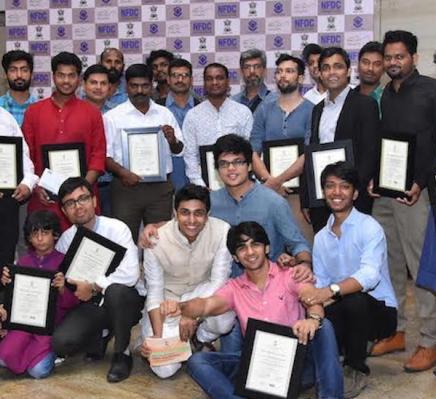
February 23, 2012
I love this site. Thank you!!
March 24, 2012
Thank you for loving it 🙂